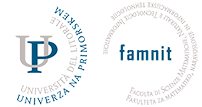četrtek, 24. julij 2025 Nikola KOVAČEVIĆ: Discrete-Event Simulation Model for Wood Waste Reverse Supply Chain in Jovan PAVLOVIĆ Integrating agent-based modeling and network science for responsive epidemic management in urban transport
V ponedeljek, 28. julija 2025, bosta ob 16:00 uri izvedeni dve
predavanji v okviru PONEDELJKOVEGA SEMINARJA RAČUNALNIŠTVA IN INFORMATIKE
Oddelkov za Informacijske znanosti in tehnologije UP FAMNIT in UP IAM.
ČAS/PROSTOR: 28. julij 2025 ob 16.00 prek Zoom-a (https://upr-si.zoom.us/j/297328207?pwd=S3Zpdk1VR3pjckNtWkQwKzlvcDR5UT09).
1. predavanje:
============
---------------------------------------------
PREDAVATELJ: Nikola KOVAČEVIĆ
---------------------------------------------
Nikola Kovačević is 2nd year Data Science master's student at UP FAMNIT, writing his master thesis under the supervision of Prof. Balázs Dávid, PhD, and Co-Mentor: Črtomir Tavžes, PhD, Research Associate. He is also working at UP FAMNIT, as part of the pilot project GDI UP.
---------------------------------------------------------------------------------------------------------------
NASLOV: Discrete-Event Simulation Model for Wood Waste Reverse Supply Chain
---------------------------------------------------------------------------------------------------------------
POVZETEK:
Wood waste management faces significant challenges due to fragmented reverse supply chains and inconsistent data reporting systems. While traditional waste management approaches rely on linear disposal methods that limit resource recovery potential, reverse supply chains enable material valorization through collection, processing, and reuse pathways. To investigate modeling opportunities for real-world applications, we developed a discrete-event simulation model using Slovenia as a case study with data from the Slovenian Environment Agency (ARSO). The research addresses i) how fragmented wood waste data can be integrated into material flow understanding, ii) where bottlenecks exist in current systems, and iii) whether simulation modeling can provide insights for intervention strategies. The methodology combines data harmonization techniques with discrete-event simulation, tracking material flows from generation through collection to final processing, while implementing capacity constraints and operational dynamics. Initial results show the framework can pinpoint bottlenecks and evaluate scenarios for circular wood-waste reverse supply chains.
Seminar bo potekal v angleškem jeziku.
=============================================================================================================
2. predavanje:
============
------------------------------------------
PREDAVATELJ: Jovan PAVLOVIĆ
------------------------------------------
Jovan Pavlović is a second-year Data Science master's student at UP FAMNIT, under the supervision of mentor Miklós Krész and co-mentor László Hajdu. He is also part of the pilot project GDI UP.
----------------------------------------------------------------------------------------------------------------------------------------------------------------------
NASLOV: Integrating agent-based modeling and network science for responsive epidemic management in urban transport
----------------------------------------------------------------------------------------------------------------------------------------------------------------------
POVZETEK:
This presentation focuses on assessing different relative effectiveness of non-pharmaceutical epidemiological interventions through agent-based modeling. A schedule-based transit assignment model, FAST-TrIPs, is employed to realistically simulate passenger movements within the San Francisco Municipal Railway public transportation system, using accurate transit demand data. These simulations enable the construction of a detailed passenger encounter network that captures interactions relevant to disease transmission. From this network, another structure known as the vehicle trip network is constructed, modeling passenger transfer patterns. PageRank centrality analysis is applied to identify vehicle trips with the highest contagion potential, and the directed Louvain community-detection algorithm is separately used to identify vehicle trips bridging passenger communities. Building on insights from both analyses, a novel social-vehicle capacity restriction policy is proposed, in which capacity is selectively reduced on vehicle trips identified as most influential in disease spread. To evaluate this policy, a discrete compartmental Susceptible-Infected (SI) model is utilized to simulate infectious disease propagation across the passenger contact network. Primary finding indicate that measures reducing per‑contact transmission probability (e.g., mask wearing) dominate infection outcomes; even intelligently targeted capacity reductions play only a minor role compared with masking. However, when the a priori infection prevalence is high, more aggressive (and especially targeted) capacity limits can still shave off a few percentage points of spread.
Seminar bo potekal v angleškem jeziku.
=============================================================================================================
Seminarja bosta izvedena online prek Zoom-a na sledeči povezavi:
https://upr-si.zoom.us/j/297328207?pwd=S3Zpdk1VR3pjckNtWkQwKzlvcDR5UT09
Meeting ID: 297 328 207
Passcode: 123456789
Vabljeni!









